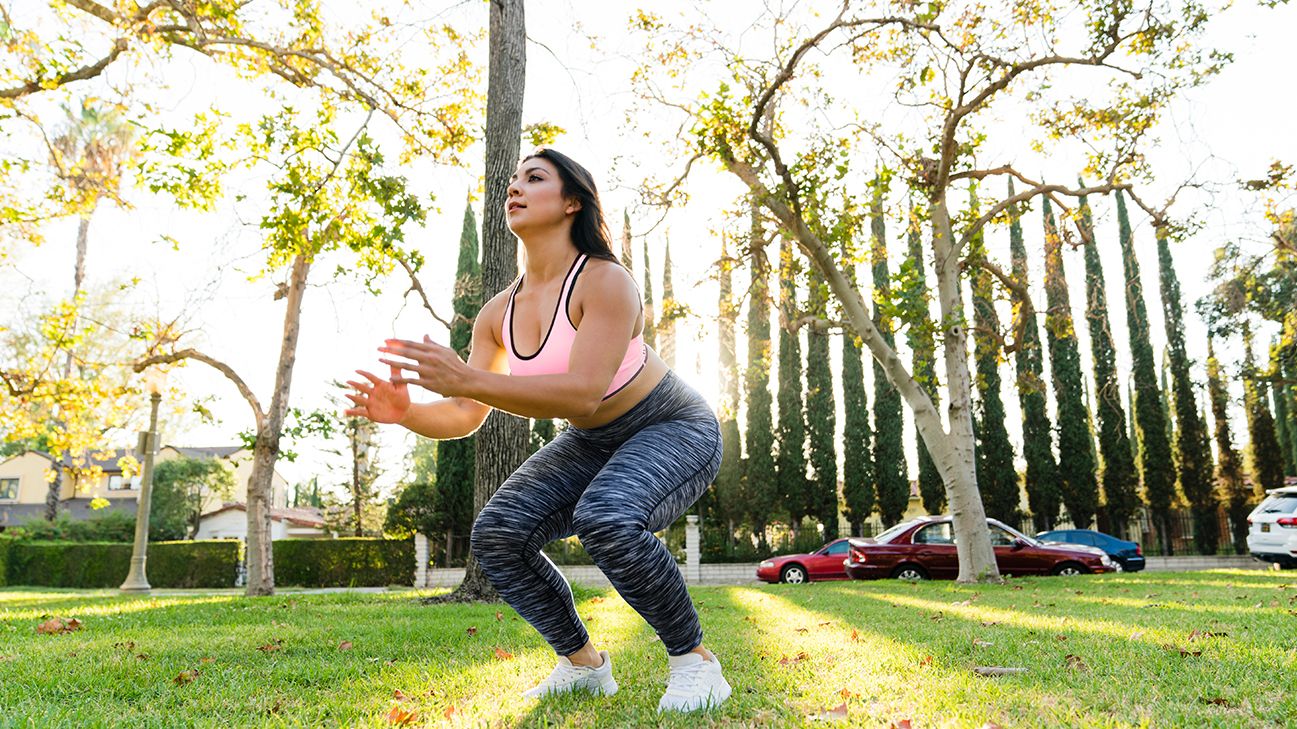Ready to give your regular old squats a boost? Enter: squat jumps.
Here’s how to take your squat (and glutes) to new heights.
How to do a squat jump (aka jump squat)
This all-around move targets your glutes, quads, hips, and hamstrings. As you lift off, your heart rate does too. That’s what makes it a powerful plyometric move (an exercise that works your muscles *and* gets your heart pumping).
Here’s what to do:
- Stand up straight, with feet slightly wider than shoulder-width apart.
- Squat until your thighs are just a bit higher than your knees.
- Drive through the balls of your feet to push yourself upward, straightening legs. (Try to get your feet to lift off the floor.)
- Land on the balls of your feet with soft, bent knees.
- Return to classic squat position.
FYI: This variation of the classic squat can put more stress on your joints. Attempt this one only if you have healthy knees, hips, and ankles.

Whether you want to become a faster runner, give your booty a boost, or just improve your overall health, squat jumps might be for you.
Getting low (and then high) with jump squats offers a load of strength and aerobic benefits, including:
- building muscle and strength
- boosting aerobic and cardiovascular fitness
- improving mobility and balance
- toning your butt, legs, and abs
- burning calories and fat
- boosting circulation
- improving sport performance
- strengthening bones
In a small 2016 study in 68 men, researchers scoped out the effects of jump squat training done 3 times a week for 8 weeks. Researchers found that the move helped participants improve several measures of fitness, including:
- sprint time
- explosive strength
- vertical jump
- max strength
- range of motion
Hannah Montana was right — everybody makes mistakes. Here’s how to avoid the most common ones when it comes to jump squats:
- When you dip, move from your hip. Don’t be tempted to propel up using your knees. This can strain your muscles and potentially injure your knees. Instead, focus on powering the move with your hamstrings and glutes.
- Land soft and easy. To reduce stress on your joints, you’ll want to make like a feline and land super softly on your feet. If you land hard, you’ll feel it. Even if you don’t feel it right away, you might endure some achy, breaky joints the next day.
- Watch those knees. As with regular squats, your knees shouldn’t move in front of your toes while you’re getting low. If you’re leaning too far forward, you could injure your knees or spine.
FYI: Keep in mind that 5 perfect squats with proper form are better than 10 struggle-city jump squats. Perfect your technique before cranking up your reps.
And remember: Challenging yourself is one thing — hurting yourself is another. If you feel any pain, stop.
Squat jumps are the perfect move to add to your routine 3–5 times a week.
Here’s how to work jump squats into your workout:
- Warm up. Get started with 5–10 minutes of light cardio.
- Jump squats. If you’re new to this, start with 2 or 3 sets of 3–5 reps of jump squats. Gradually, you can work your way up to sets of 12–15 reps (or more).
- Work it out. Move on to the rest of your workout, whether you’re doing strength training, cardio, or HIIT.
- Cool down. Stretch or walk it out.
Pro tip: To make things more comfy, you might want to put down a workout mat or move to a soft surface like grass or carpet.
The jump squat is a killer way to work your glutes, quads, hips, and hamstrings. Since it provides both strength training and cardiovascular benefits, it’s a stellar part of a well-rounded workout. Just make sure to perfect your form first.
If you have knee, hip, or ankle probs, it’s best to skip this one. If you’re not sure whether this move’s right for you, talk with a doctor, physical therapist, or certified personal trainer.

